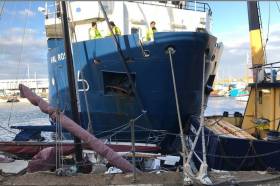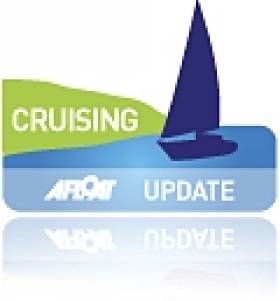Displaying items by tag: Scilly Isles
Freightship Crashes Into Boats In Penzance Harbour Collision
#ports&shipping - An investigation has begun into how a new freightship introduced last month for the Isles of Scilly, crashed into boats moored in Penzance harbour.
According to CornwallLive, the 842-ton ship collided with a yacht and trawler in the enclosed harbour area on Saturday evening.
No one was injured in the collision and the full extent of the damage is still being assessed. The company which runs the ship said it had launched a full investigation.
Last month, the Norwegian-built Mali Rose replaced the veteran ship Gry Maritha, which had run between Penzance and the islands for 27 years. The Mali Rose is larger than the Gry Maritha, at 50 metres by 10 metres, and the Isles of Scilly Steamship Group said at the time that part of the crew's training involved handling the larger ship.
A spokeswoman for the Isles of Scilly Steamship Group confirmed that the ship was involved in the incident.
To read more on the story click here.
Record-Breaking Conditions Ahead for Fastnet Race
The largest, most diverse fleet of racing boats ever in offshore yachting set sail this morning in the Rolex Fastnet Race.
The biennial flagship event of the Royal Ocean Racing Club, a tradition since 1925, will take the fleet some 608 miles from Cowes on the Isle of Wight along the UK's south coast and across the Celtc Sea to Fastnet Rock off the Cork coastline, before returning past the Scilly Isles to the finish line at Plymouth.
An incredible 318 yachts are competing this year and they come in all shapes and sizes, from the 40m trimaran Maxi Banque Populaire to the 9.1m Rogers 30, Brightwork.
The majority of the fleet will be racing under the IRC for the Fastnet Challenge Cup, won by the crew that sails best to their rating. The weather will play a big part in this, as a fast start and slow finish favours bigger boats - so far today looks to be the opposite.
The 45-55 foot boats will surely provide the most competitive action, with past Fastnet winner Piet Vroon piloting his championship-leading Ker 46 Tonnere de Breskens towards another victory.
Fans of the Volvo Ocean Race will also be watching the race live tracker intently today, as this is one of the only times many of the competitors will line up together before the start of the round-the-world yachting challenge.
Regatta News has more on the story HERE.
Former Soviet-Bloc Liner Continues Cruising
Cruising off the east coast of Leinster this evening is the veteran cruiseship Marco Polo which is bound for the Scilly Isles off Land's End, writes Jehan Ashmore.
For those with an appreciation for the more traditional tiered deck profile compared to the bulky new giant cruiseships, the 22,080 tonnes vessel built as the Aleksandr Puskin at the Mathias-Thesen-Werft, East Germany, certainly represents a different era.
The liner entered service in 1966 with the Baltic Shipping Company on their regular trans-Atlantic Montreal-Leningrad service. In 1975 she was converted for her new role as a full-time cruiseship. For a cut-away deck profile and description of facilities click here.
She can take 850 passengers accommodated in 450 cabins. Her main dimensions reflect her ocean-going design noting her draft is 8.2m (26.9ft) with a length of 176.3m (578.4ft) and a beam of 23.6m (77.4ft). Crewing is divided between senior officers (international) and cruise staff and entertainers are both British and comprising of other nationalities.
In recent years Marco Polo served the German market but she now is run by Cruise & Maritime Voyages (CMV) on cruises from the UK. The company also operate the Ocean Countess which first started out her days as Cunard Countess.
Waterford Club Plans June Scilly Isles Cruise
Although Waterford Harbour Sailing Club is well known for its dinghy sailing and picturesque location it has never really been seen as a hub for sailing cruisers.
Consequently there has never been a big event for the big boats at the club but, says club secretary Rene Wubben, that's about to change this season with a Scilly Isles Rally from Dunmore East in June.
Waterford Harbour is keen to attract as many boats as possible from its own club but also others nearvy for the cruise in company that departs Dunmore East on June 16th. More info from Waterford Harbour Sailing Club. Tel: 051 383389
2011 Afloat Almanac: If you're contemplating a cruise, short coastal passage or even just studying for a Nav course this season, don't forget the 2011 edition of the Afloat Irish almanac (with Reeds Data). It covers the whole of Ireland, the Scottish, English and Welsh West coasts. Buy it online. CLICK HERE Easy!































































